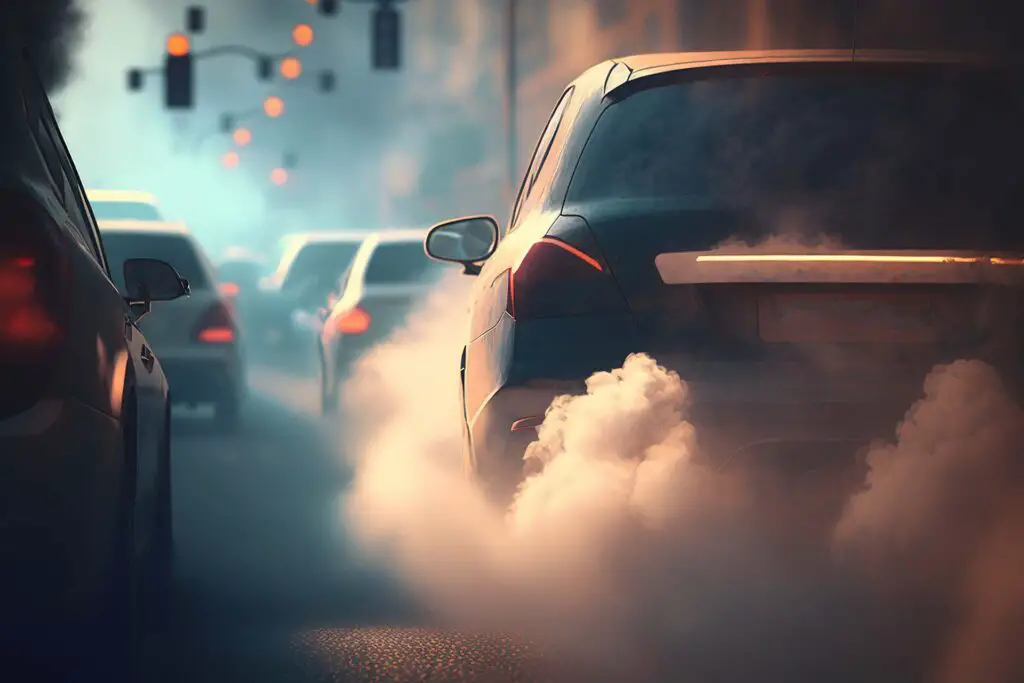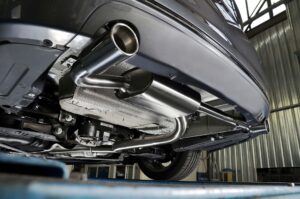If you’ve ever seen smoke from car exhaust, then you know it isn’t a great sight. It isn’t just a nuisance – it can be indicative of something more serious, typically a problem in the engine or emission system that needs to be addressed. So, why does a car smoke from the exhaust? Let’s discuss the culprits behind this problem and the steps you need to take in order to fix the issue.
What Are the Causes of Smoke From Car Exhaust?
Have you found yourself wondering recently – why am I constantly smelling car exhaust fumes? No matter if you own a brand-new car, a used vehicle, or even one with a salvage title, smoke coming from the exhaust when starting the car or cruising down the road is far from a pretty sight. Identifying the issue is the necessary first step in solving this problem, so let’s take a look at the most common culprits:
Fuel-Related Causes
Smoke from the exhaust is most commonly an indicator of fuel-related problems. There might be wrong gas in your vehicle or an imbalance in the fuel-to-air ratio due to a malfunctioning fuel pressure regulator, making it not burn completely and resulting in black smoke. There’s also a possibility that there is water or coolant fluid in the mixture. This can occur due to a blown head gasket or a cracked engine block, and it creates white smoke that might be visible from the exhaust.
Like incompatible fuel mixtures, overloading the engine with excessive fuel can also cause incomplete combustion, leading to black smoke emitting from your vehicle. This can happen accidentally or due to leaking fuel injectors. These issues can affect engine performance and fuel efficiency, so it’s best to address them head-on before they further damage your four-wheeler.
Oil-Related Causes
Oil-related causes are another common reason, and it’s typically due to overfilling the engine with oil. When there’s excessive oil consumption in the combustion chamber, it will burn along with the fuel and produce blue or gray smoke coming from the exhaust pipe. This can occur due to worn piston rings, damaged valve seals, or a faulty positive crankcase ventilation (PCV) valve.
Regular maintenance and inspection can help detect these issues early and prevent further damage to the engine. Additionally, ensuring the correct oil level and using the recommended oil type can help prevent these issues. To ensure optimal performance and fuel efficiency, it’s important to address this issue as soon as you see the blue or gray smoke escaping from the exhaust pipe.
Other Causes
The situation is not getting any simpler, as there are many other factors that could turn out to be the culprit. As mentioned, an imbalanced fuel-to-air ratio can produce black smoke – this can happen because of a malfunctioning fuel pressure regulator, but it can also be the result of something as simple as a clogged air filter.
The oxygen sensor and the mass airflow sensor are also helping regulate the fuel-to-air ratio, so their malfunction can cause smoke from the exhaust, usually black, white, or blue. Additionally, a catalytic converter, designed for converting harmful gasses into less harmful ones, can cause smoke that’s combined with a rotten egg smell if it’s damaged or not functioning properly.
What Is the Impact of Car Exhaust Smoke?
You don’t have to be a die-hard gearhead to know that the smoke coming from your four-wheeler is not exactly great for the environment and the health of you and your loved ones. It’s important to familiarize yourself with these negative impacts in order to work towards ensuring the safety and performance of your vehicle, as well as minimizing its effect on the environment and human health.
No matter if you’ve been graced with living in one of the cities with the worst drivers or frequently cruising down the famous routes in the US, it’s crucial to have an awareness about this problem and take steps to prevent it – after all, it’s our only ticket to a cleaner and healthier environment for all.
Environmental Impacts Are Numerous
Vehicle emissions can have a wide variety of consequences, both on the environment and human health. Actually, these are tightly intertwined, as air pollution can lead to respiratory problems and other health issues. That’s because smoke from the exhaust pipe of your four-wheeler contains a handful of harmful pollutants, such as:
- Carbon monoxide (CO) – a colorless, odorless, and poisonous gas that reduces the amount of oxygen that can be carried by the blood,
- Nitrogen oxides (NOx) – a group of gasses that contribute to the formation of smog and acid rain and can cause various respiratory problems,
- Particulate matter (PM) – tiny particles of solid or liquid that can be inhaled and cause respiratory problems, including asthma, bronchitis, and lung cancer.
This pollution can harm the environment, including plant and animal life, by contaminating soil, water, and air. Additionally, the emissions contribute to climate change by releasing greenhouse gasses that trap heat in the atmosphere, leading to global warming. These gasses can also contribute to the formation of smog, which can reduce visibility on the road, damage crops, and also cause respiratory problems in humans.

Health Impacts Include Various Respiratory and Cardiovascular Problems
If it’s bad for the environment, you can bet it’s bad for your health as well, especially if you have a preexisting condition or are regularly exposed to these exhaust gasses. As mentioned, they contain harmful chemicals which can cause respiratory problems, such as shortness of breath, coughing, and wheezing. Prolonged exposure to these pollutants can also lead to more serious respiratory issues, such as asthma and bronchitis.
These emissions can also cause cardiovascular problems, including heart attacks and strokes. In addition, some of the chemicals that can be found in car exhaust, such as benzene and formaldehyde, are known carcinogens, which means they can significantly increase the risk of cancer.
Unaddressed Issues Can Become Safety Hazards
Last but not least, unaddressed issues with a vehicle’s exhaust system can become a safety hazard, as it indicates underlying problems with the engine or other parts of the vehicle. If not fixed, these issues can lead to engine damage or other safety hazards, such as decreasing braking ability or steering control.
For example, a damaged catalytic converter can restrict the flow of exhaust gasses, which can cause the engine to stall or reduce the power of your vehicle, significantly compromising safety. So, if you address these issues head-on, you’re ensuring a safe ride with optimal performance, as well as a cleaner environment for all.

How to Address Smoke From Car Exhaust
Now that you know the common culprits, as well as the extent of their negative effects on the environment and human health, it’s time to talk about how to go about resolving these issues. As it depends on the cause of the problem, it’s best to consult a professional mechanic, as they have the expertise and equipment to diagnose and repair issues accurately.
Regular Vehicle Maintenance
A big part of addressing this problem is taking your four-wheeler on regular maintenance checks, including oil changes and engine inspections. The first one entails ensuring that the engine is properly lubricated and with no contaminants, while the second can help identify issues such as worn piston rings or faulty valve stem seals.
Regular maintenance can also help prevent issues with the fuel system, such as a clogged fuel injector or malfunctioning fuel pressure regulator, that might be the cause of the smoke. This can prevent many of these issues from occurring in the first place or help fix them by establishing the issue ahead of time.
Develop Proper Driving Habits
Developing and keeping up with good driving habits can help reduce the likelihood of a problem with exhaust smoke. One essential habit is to drive the vehicle gently and avoid hard acceleration or braking, which can cause excessive wear and tear on the engine and other parts of the vehicle, such as the braking pads. Additionally, drivers can reduce the load on the engine by removing any unnecessary weight from the vehicle and avoiding overloading it.
Using the appropriate fuel type is also one crucial driving habit every car owner should have, as it ensures optimal performance and efficiency. Different vehicles require different types of fuel, such as gasoline, diesel, or ethanol blends, and using the wrong fuel can cause further issues with the engine.
Or you can maybe forget all that and invest in an all-electric vehicle (EV), the most eco-friendly mode of transportation at this moment. But EVs come with a high price tag, so if you’re not ready for that kind of investment yet, you can help reduce emissions by avoiding idling, as well as carpooling, using public transportation, and walking or cycling whenever possible.
Upgrade Vehicle Parts
While the aforementioned tips are good for minimizing the likelihood of further issues developing, sometimes the only solution is to change or upgrade vehicle parts at your local mechanic shop. Depending on the issue, there are a few possible scenarios, and here is an overview of them:
| Malfunctioned Vehicle Part | Repair Process | Average Cost of Repair |
| Air Filter | Needs to be replaced with a new one every 12,000 to 15,000 miles | $20-$50 |
| Fuel Filter | Needs to be replaced every 20,000 to 30,000 miles or according to the manufacturer’s instructions | $50-$100 |
| Spark Plugs | Should be replaced every 30,000 to 100,000 miles or according to the manufacturer’s recommendation | $100-$200 |
| Oxygen Sensor | Typically last for 100,000 to 150,000 miles and should be replaced when they fail or as part of routine maintenance | $100-$300 |
| Timing Belt | Should be replaced every 60,000 to 100,000 miles or according to the manufacturer’s recommendation | $500-$1,000 |
| Catalytic Converter | They fail due to age or damage, and they must be replaced immediately to maintain proper engine function | $500-$2,500 |
No matter the specific issue with your four-wheeler, it’s important to upgrade it with high-quality parts that will improve the flow of exhaust gasses and, in turn, improve the performance of the engine and reduce the likelihood of the exhaust smoke resurfacing. By doing your part, you’re not only ensuring that you have a reliable road companion, but you’re also bringing positive changes to the environment.

Learn How to Deal With Smoke From Car Exhaust and Have a Better Driving Experience
All in all, despite the many potential causes behind this issue, they all share one common factor – exhaust smoke can have an adverse effect on both human health and the environment. That’s why everyone should make an effort to reduce the amount of emissions they produce while driving – small changes can work together and bring big changes in the long run. Now it’s up to car owners and citizens alike to do our part in eliminating the issue – so buckle up and have a safe ride!








